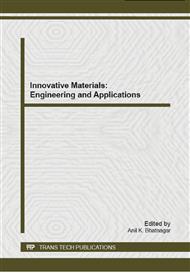p.45
p.51
p.55
p.61
p.65
p.69
p.73
p.79
p.86
Polyurethane Nanocomposite Films by Using Cellulose Nanospheres as Green Nanofillers
Abstract:
To overcome poor mechanical properties of polyurethane, carboxylated cellulose nanospheres were incorporated into polyurethane in an organic polar solvent, dimethylformamide to prepare the nanocomposite films. Morphological, structural, mechanical and thermal characterization of the nanocomposites was done with scanning electron microscopy, Fourier transform infrared spectrometry, micro–control electronic universal testing machine and thermal gravimetric analysis. The critical challenge to achieve high macroscale properties of the bulk nanocomposites is the ability to obtain well–dispersed cellulose nanospheres in polymer matrices.
Info:
Periodical:
Pages:
65-68
Citation:
Online since:
October 2014
Authors:
Price:
Сopyright:
© 2014 Trans Tech Publications Ltd. All Rights Reserved
Share:
Citation:


